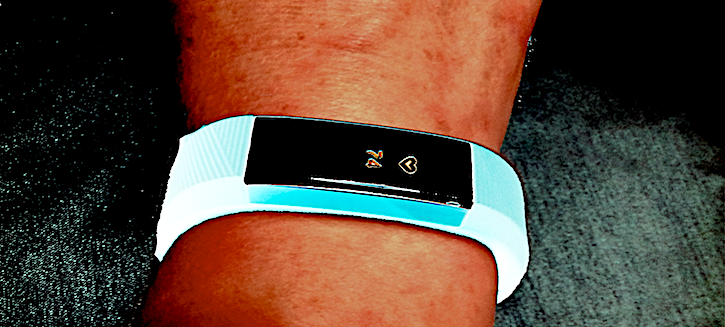Wearables Could Help Researchers Evaluate Cancer Treatment Progress
Researchers found that the data they generate correlated closely with cancer-related quality of life scores.

A Fitbit device in use. Image courtesy Wikimedia Commons user PamD. Image has been cropped and stylized.
It’s a foregone conclusion that wearables can do far more than just provide people with their daily fitness information. In a new study from the University of Texas Southwestern’s Simmons Cancer Center, they were found to be ergonomic tools for tracking physical activity in older cancer patients, and the data they provided correlated closely with other quality-of-life assessments.
The pilot program recruited 24 cancer patients with a mean age of 54. They assessed patients on the Eastern Cooperative Oncology Group Performance Scale (ECOG PS), which rates how a patient’s mobility and activity from 0 (“Fully active, able to carry on all pre-disease performance without restriction”) to 5 (“Dead”). All participating patients scored 0, 1, or 2, on the ECOG PS.
>>READ: How a Fitbit and Virtual Coaching Helped Cardiac Patients Maintain Their Fitness
All patients were given a personal activity monitor to wear throughout their daily routine. All but 1 completed the study at a 69-day median duration of follow-up. Steps per day were associated with ECOG PS: Patients who were rated a 0 walked an average of more than 5,900 steps, a bit above the average American’s daily activity. Patients rated 1 on the scale (“Restricted in physically strenuous activity but ambulatory…”) had a significant dropoff to about 1,900 daily steps, while those rated 2 walked less than 900 (“capable of all selfcare but unable to carry out any work activities”).
The researchers also found a strong correlation between the tracked steps per day and other established quality-of-life scores, like Brief Fatigue Inventory and Functional Assessment of Cancer Therapy—General. Exactly 75% of patients reported having a positive experience with their wearable device.
The study’s first author, Arjun Gupta, MD, noted that the low attrition rate and overall positive response was an encouraging sign for the technology’s usability among elderly cancer patients.
Senior author Muhammed Beg, MD, MS, called the work “the first step” towards understanding the valuable that wearables might bring to cancer therapy monitoring. “My hope is that we can use wearable devices in large cancer clinical trials. That way, we can see what the true effect of different cancer treatments are on patients' physical activity,” he said.
The research was published this week in JCO Clinical Cancer Informatics.
Related Coverage:
First Clinical Trial of mHealth Adherence App as a Standalone Yields Little Improvement
Newsletter
Get the latest hospital leadership news and strategies with Chief Healthcare Executive, delivering expert insights on policy, innovation, and executive decision-making.